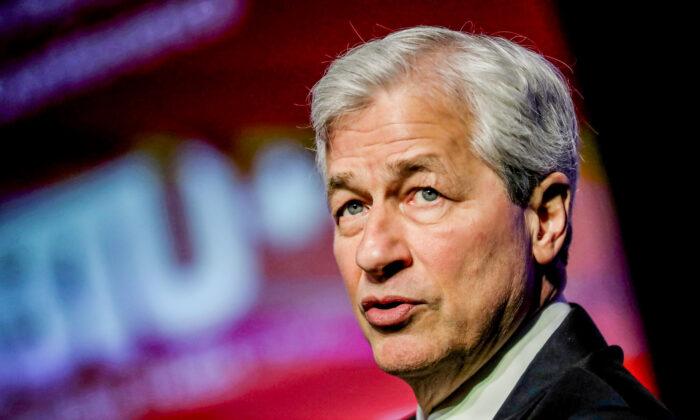JPMorgan CEO Jamie Dimon has warned that inflation could accelerate again and that a recession could well materialize if the Federal Reserve takes interest rates higher in response to resurging price pressures.
“A lot of things out there are dangerous and inflationary. Be prepared,” Mr. Dimon said at the 2023 New York Times DealBook Summit in New York on Nov. 29, during which he said that geopolitical tensions and the energy transition were prompting governments to ramp up spending, which is inflationary.
A new inflationary spike would pressure the Fed to raise interest rates further, which would have a cooling effect on the economy.
“Interest rates may go up, and that might lead to recession,” Mr. Dimon said, while expressing caution about the economy, especially the effect that inflation has had on U.S. households.
He added that the Fed’s fast pace of raising interest rates (which went from zero to more than 5 percent at the quickest pace since the 1980s), along with a reversal of its quantitative easing program, were squeezing the economy and consumers.
So far, there’s been a limited effect of higher interest rates and geopolitical tensions on U.S. consumers, who have continued to spend despite signs of an economic slowdown.
‘Most Dangerous Time’ In Decades Is Here
Earlier, Mr. Dimon sounded the alarm that U.S. consumers were running down their excess cash buffers while issuing a somber warning that “the most dangerous time” the world has seen in decades has arrived.While warning of clouds on the horizon of consumer spending, “extremely” high government debt levels, and the largest peacetime fiscal deficits in U.S. history, Mr. Dimon said in mid-October that he sees a growing risk that inflation stays high and that the Fed will raise interest rates even higher.
He also singled out the disruptive effect of the war in Ukraine and the Hamas terror attacks in Israel, warning of “far-reaching impacts on energy and food markets, global trade, and geopolitical relationships.”
“This may be the most dangerous time the world has seen in decades,” he cautioned while warning that Americans’ excess savings were being depleted and that if consumers pull back, an economic downturn isn’t far behind.
An October report from the Federal Reserve Bank of New York revealed that Americans’ disposable income had fallen and that consumers were increasingly dipping into the savings to prop up consumption.
From the beginning of the pandemic in 2020 through the end of 2021, Americans’ excess savings grew to roughly $2.6 trillion, or 14 percent of annual disposable income, according to the New York Fed.
Since then, U.S. excess savings have steadily fallen, dropping to 10 percent of disposable income—or $1.9 trillion—by the second quarter of 2023.
Data for the first two months of the third quarter cited by the New York Fed show that consumers have generally maintained their propensity to spend, but as real disposable income has fallen, they’ve increasingly been drawing on their savings to continue shopping.
Even though the latest data show that the U.S. economy expanded at a solid clip of 5.2 percent in the third quarter, the numbers looked far less impressive on the income side, and other data suggest the economy is cooling.
Consumer Sentiment Slides as Inflation Fears Revive
In a warning sign for the economy, U.S. consumers have grown more pessimistic as inflation concerns surged to a 22-year high.The drop marks the fourth consecutive month of declines in the sentiment measure, with the deepening confidence slump coming as the geopolitical crises in Ukraine and Gaza show no sign of ending anytime soon.
Meanwhile, inflation expectations jumped for both the near and long term, reflecting consumer fears that the recent easing of price pressures would be short lived.
U.S. consumers expect inflation to average 4.5 percent over the next 12 months and 3.2 percent in the next five years, according to the University of Michigan survey. That’s up from the 4.2 percent and 3 percent, respectively, that consumers predicted when asked in October.
In particular, the five-year inflation expectation reading is the highest in 22 years.
“Consumers appear worried that the softening of inflation could reverse in the months and years ahead,” Joanne Hsu, University of Michigan Surveys of Consumers director, said in a statement.
The jump in inflation expectations comes despite the fact that the consumer price index, a measure of inflation, fell to 3.2 percent in October from 3.7 percent in September.







